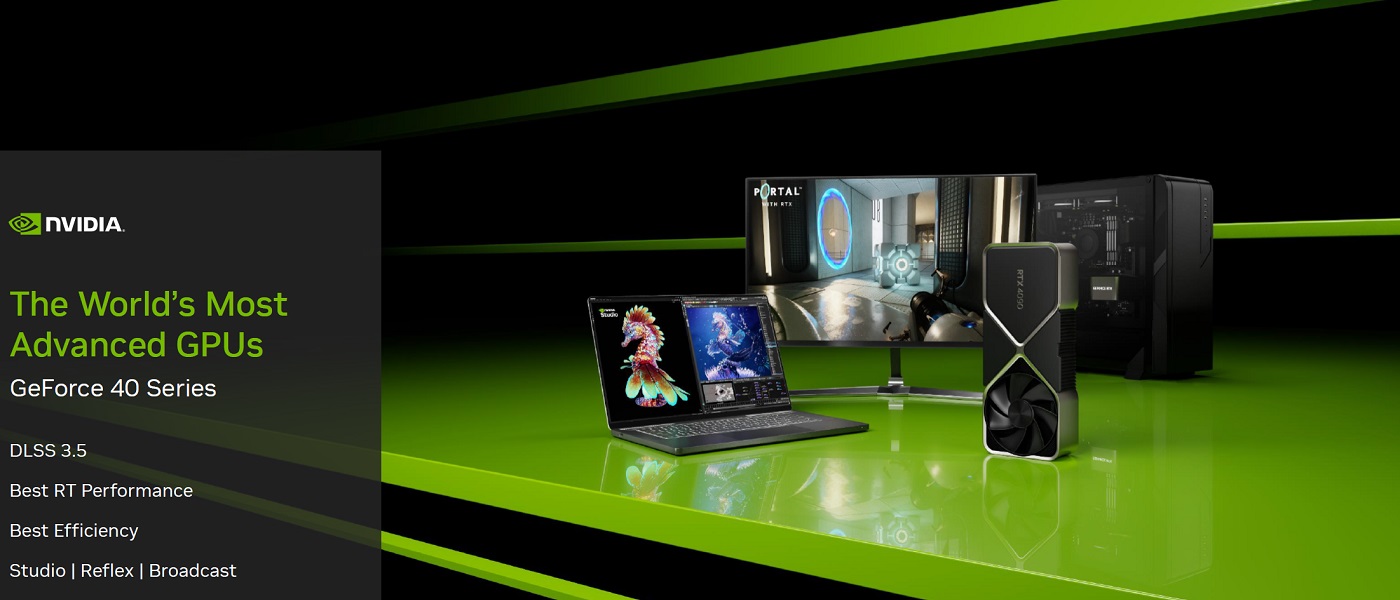A few days ago I had the opportunity to participate in a presentation “behind closed doors”. NVIDIA DLSS 3.5, an interesting update to the technology that revolutionized the graphics sector and was undoubtedly a huge game changer. The news it brings is very interesting and I will bring it to you in detail in this article, but first I want to share with you an overview of the history of DLSS so that you can see in summary its beginnings and its development.
I’m sure you all remember debut of DLSS technology. It was in 2019 and it came to the market as a two-stage spatial rescaling method supported by artificial intelligence for image reconstruction with hardware-level acceleration. tensor kernels The acceleration of this technology was ensured by the second generation GeForce RTX 20, although the result obtained by NVIDIA did not meet the expectations created.
The first breakthrough came with DLSS 2

NVIDIA did not throw in the towel in 2020 we were surprised by DLSS 2a technology that completely exceeded our expectations and became a huge success thanks to the improvements it made in terms of both performance and image quality, showing that upscaling has its place in the PC world.
With DLSS 2 it is possible up to three times the performance in games starting with 4K resolution, and thanks to the use of spatial and temporal elements, information from previous frames, data from the buffer and exposure and brightness, as well as motion vectors and artificial intelligence, it was possible to significantly improve the image quality.

DLSS 2 technology is not limited to scaling, performs an intelligent image reconstruction process it collects a large amount of information and uses it to generate the perfect frame. The results obtained are so good that DLSS 2 in quality mode exceeds in many ways the quality we would have with native resolution, although it excels especially in the representation of distant objects and in smoothing edges thanks to the TAUU (Temporal Anti-Aliasing Upsampling) that applies.

In 2021, NVIDIA released a major update that brought us to DLSS 2.3. This update brought improvements to particle reconstruction and stability during the temporary reconstruction process. Also greatly reduced spiritsa problem that mainly affects objects that move at high speed and that leave a small trail during their trajectory.
Image generation once again demonstrated the power of AI

With DLSS 3, there was an important division of the technology into two main variants, great resolutionwhich is what we know as DLSS 2, and frame generationwhich falls under DLSS 3, and showed that AI not only has a lot to say when applied to gaming, but that it can make the impossible possible.
The Frame generation was introduced in October 2022 as a GeForce RTX 40 exclusive, and it was a very wise move by NVIDIA, because in the end the smart rescaling and rebuilding no longer had much room for improvement and a huge bottleneck that occurs as the resolution goes down further and further it caused performance improvements to become regressive at certain levels.

Image generation again uses artificial intelligence, but this time relies on an optical flow accelerator, a component that is key to creating an accurate prediction of how all the objects and elements in a frame should look, which is generated completely independent of the GPU, using information from the two frames in between. motion vectors and optical flow
It only has Optical Flow Accelerator GeForce RTX 40 required accuracy and performance for the frame generation to work properly, which is why this technology is unique to this generation of graphics cards. It could have been implemented in previous generations, but NVIDIA didn’t because the result wouldn’t be good and the experience would be counterproductive.

In January 2023, NVIDIA updated to DLSS 3.1a version that improved the stability of the game interface when activating frame generation and also significantly increased the image quality even in scenes where the movements of characters and other elements of the scenery are very fast.
NVIDIA DLSS 3.5: A lightning-fast AI overhaul is coming
Ray tracing is such a demanding technology that it is not possible to use it in games without resorting to artificial intelligence in one way or another. NVIDIA has taken two very effective approaches in this regard with Super Resolution and Frame Generation and with DLSS 3.5 it has achieved the seemingly impossible, which once again surprised us with an improvement that will make a huge difference.

DLSS 3.5 introduces what’s known as artificial intelligence ray reconstruction, using AI to deliver an improved ray tracing experience in both graphical quality and performance. Yes, it does thanks to DLSS 3.5 ray tracing it is a level higherand we will enjoy more fluidity in games.

To understand how the ray reconstruction used by DLSS 3.5 works, it is necessary to be clear about how the traditional ray tracing pipeline applied to lighting works. As we can see in the attached picture, the graphics engine first generates the geometry and raw materialswithout using lighting.
Once this step is complete, lightning strikes generate lighting effects and reflections, but in a limited way, as it would not be possible to generate a beam for each pixel and accompany it with multiple reflections. The load it would carry would be unaffordable for any current PC. Consequently, we have “dirty” image with lots of noise because pixels are missingso it is necessary to apply noise reduction technologies that are normally tuned manually.

After applying this noise reduction, we get a composite image with low-resolution rays, which will eventually be adjusted to achieve the target native resolution. Silencers play a very important role, but have flaws that in the end the result is not as good as one would like.

They use two large keys to reduce noise and get a cleaner image that can be displayed in the game, temporal accumulation and spatial interpolation. The former uses multiple frames to try to accumulate good quality pixels and tries to remove those that are of poor quality, while the latter looks at nearby pixels in the same frame and combines them to improve the image quality. These two techniques applied as they work, but present significant problems:
- Inaccurate lighting effects by accumulating low-quality pixels from previous images.
- Low quality global lighting because spatial interpolation is not able to capture enough data.
- low quality reflexes because spatial pixel interpolation is unable to obtain the information it needs to create a highly detailed image.

In this sense, it is important to emphasize an important part of the necessary information will be lost during the noise reduction process, such as high-frequency color data, which will ultimately greatly affect the image enhancement process and lead to quality loss.
DLSS 3.5 technology, also known as Ray Reconstruction (“Ray Reconstruction”), is NVIDIA’s answer to classic noise limiters. This works in conjunction with super resolution to achieve a noticeable performance improvement and its duty cycle is perfectly summarized in the attached image.

As we can see the traditional basis is preserved, which means doing the whole process of generating the geometry and materials as well as firing the rays. Motion vectors are used, followed by flash reconstruction and Super Resolution, both using time elements. Subsequently, frame generation using an optical flow accelerator can be used.
How flash reconstruction works
This technology does a job similar to that of noise suppressors, but we are dealing with intelligent technology that is trained to do so incorporate additional data from the graphics engine, including motion vectors and surface colors. This technology runs on tensor coresand does not depend on the optical flow accelerator.
She is also trained for this recognize different ray tracing effects, for distinguish between good and bad pixelsfor better association of spatially related pixels and also k store more data for the final image enhancement process (“upscaling”).

In the image just below these lines, we can see an example of how beam reconstruction works and how it compares to traditional noise limiters. DLSS 3.5 intelligently recognizes patterns to create better lighting effects based on multiple flash samples taken from multiple images. Intelligently distinguishes good pixels and removes bad pixels, and this allows you to offer a clearly better result.

With DLSS 3.5, realism is greatly improved when ray tracing is activated, resulting in excellent image quality. In particular, look at the Cyberpunk 2077 image, without the DLSS 3.5 lighting that comes from the car it is exaggerated on the sides and has insufficient and imprecise range.

However, when the beam reconstruction is activated, the headlights will light up fits perfectly in the shape of a coneit hits the surrounding elements like the concrete block and the palm tree on the right more intensely, and also it has the range it should because it lights up the fence in front of it.

How this technology improves reflections can also be seen in Cyberpunk 2077. Again, look at the attached image, without DLSS 3.5Lthe sharpness and level of detail offered by the reflection on the ground is clearly lower, so much so that thanks to this technology we can even read what it puts into the reflection.

Sounds good, but how does it affect performance? Well, the most interesting thing is that ray reconstruction not only improves the graphic quality when ray tracing is activated, but also it also has a positive effect on performance, as we can see in the attached image. NVIDIA has confirmed that DLSS 3.5 will be supported with all GeForce RTX 20 and higher graphics cards, which means it won’t be exclusive to the new GeForce RTX 40.

The first games that will support this technology are Cyberpunk 2077: Phantom Liberty, Portal RTX and Alan Wake II. It will also integrate with professional applications such as the Omniverse platform, Chaos Vantage and D5 Render. We’ll be able to test DLSS 3.5 starting this fall, so we won’t have to wait too long.

































